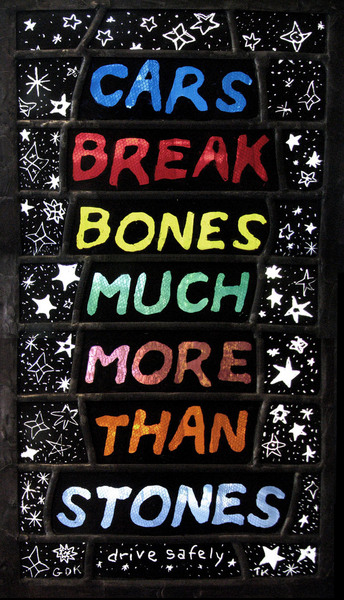February 06, 2010
Strange Interlude - Screenprinting edition
A little unexpected personal backstory. This is a video with my old friend Geoff talking about screenprinting. Geoff was one of my roommates in the 80's, and we became good friends. We used to talk about screenprinting back then and those conversations are one of the reasons I thought about applying screenprinting to my stained glass. Geoff was also the one who first heard about the Print Gocco process and inspired me to try it.
Just to prove the connection, here is a roll of reject 'Twigs' wallpaper that I got from Geoff and still occasionally use for gift wrap.
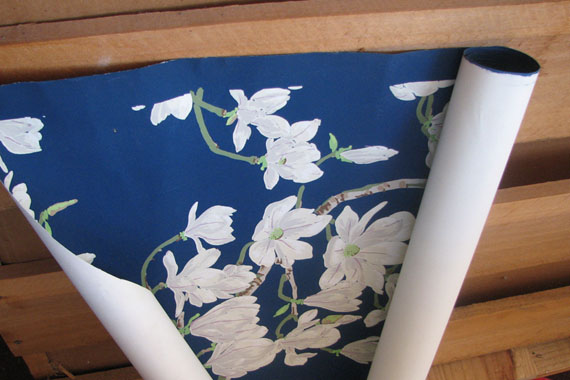
and a scan with 'The Twigs' name -
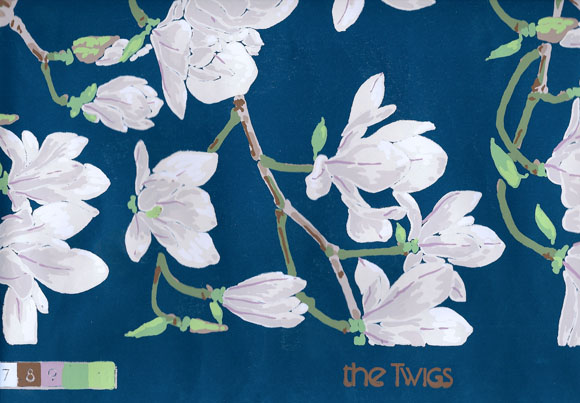
June 28, 2009
Cars Break Bones...
The first stained glass co-production of Gwyneth D. Krepcio and Tom Krepcio.
Based on an incident in May when my ten year old daughter Gwyneth and I were nearly hit by a car while walking the dog in the streets of St. Louis. The cel-phone-wielding SUV driver didn't see us while we were crossing an intersection and we had to bolt into a full run to avoid getting hit. The SUV missed Gwyneth by inches. I was livid and we were both seriously spooked by the whole thing. As soon as we got home, Gwyneth wrote out the poem. I worked up the design shortly after, adding the 'drive safely' at the bottom. We picked out the colors/glass together, and she even cut some of the glass! She scratched out the stars, I did the lettering, fired the glass and assembled the final panel.
May 02, 2007
TIME warp
It's unusual to see a print magazine fully archive their articles on the web and doubly unusual to see a print magazine archive pre-web articles on the web. That's why it's so strange to see this article on the web about stained glass, called Stained Glass, Back and Blooming, originally published by TIME magazine in March of 1978!
The funny thing is that I very well remember this article when it first came out. It was quite something at the time that a 'major news weekly magazine' was recognizing stained glass. I remember the photo shown with the article (not shown on the website) of a Ray King window - abstract, sort of Schaffrath-lite. This came on the heels of the relative success of the book "New Glass", and a number of the artists in that book are in the TIME article. I was a teenage stained glass hobbyist less than 2 years away from my first professional job in stained glass and it was nice to see stained glass getting some ink in a well circulated magazine.
All in all, a curious flashback.
September 29, 2006
Thinking about Drawing again.
With the drawing blog back up and running after a lengthy summer hiatus, I think of drawing again. In my trip to Boston, I just missed seeing the exhibit, Under Cover - Artist's Sketchbooks, at the Fogg, though I did get a report from my friend Alice. Sketchbook shows are tricky in that they either show a real sketchbook, but only one page or they take it apart and it is no longer a sketchbook, but a bunch of drawings. The Fogg didn't seem to do much in the exhibit for this but they have created a website that at least gives some idea of the progression of images in a variety of sketchbooks, even if the images are maddeningly tiny.
my current sketchbook -
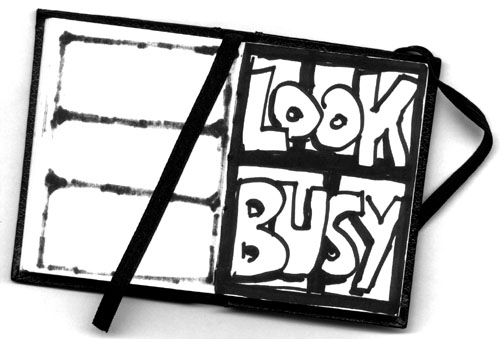
September 09, 2006
Living the Chaotic Life
I sometimes think that life is like an English Jumble Window...
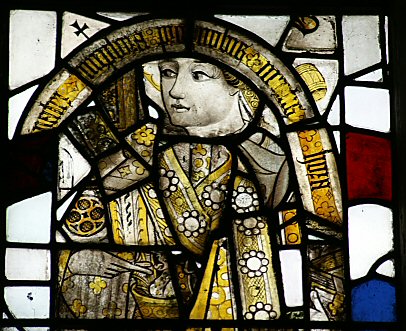
Well, my life anyway.
August 26, 2006
Flickring sign
While I'm trying to get everything into the new studio (one more weekend?!) I came across this on Flickr. I'll just take it as a sign in the midst of difficult times...
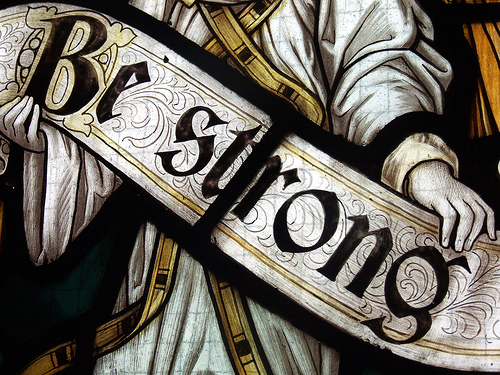
Flickr now has a group for 'stained glass'. I may join when things settle down a bit. I am surprised to see that there are already over 500 members. The photos certainly present lots of good stuff for your basic stained glass junkie, especially all the details. Yum.
August 03, 2006
New Studio Forthcoming
I was away for a few weeks working in the Boston area (and resting a little on the Connecticut shore). I have much to post about from this trip and I still have some thoughts about the GAS conference....BUT... that has to wait as I'm currently moving into a new studio space and all my free time is being consumed by that. I am excited about it, something I haven't had in awhile, a nice live/work space. More as this develops...
some pictures - "before"
May 08, 2006
Through the Looking Glass
I've got a piece, Standing Quilt, on exhibit in a show at Art St. Louis, opening this Saturday, May 13th. From the Art St. Louis website -
For this all media juried exhibit, artists were asked to submit works in all media that explore transparency, reflections or images--both real or imagined.
March 22, 2006
Workshops
Finally, after years of being asked "Do you do workshops?", I've set up some workshops. 'Computer-aided Stained Glass Design using Adobe Illustrator' is on June 13th, just before the G.A.S. Conference and 'Screenprinting for Stained Glass using the Xpresscreen system' is on June 18th, the day after the conference. More information on the Current Projects page of my website.
October 12, 2005
Sendak's Descent into Limbo
From the MITWorld website, a video of a talk by Maurice Sendak at MIT in 2003.
Amazing and astonishing as usual. The talk is more than an hour long and filled with wonderful new stories, especially his story about finding the grown up Rosie, some 20 years ago. Funny and poignant and always a joy, I've seen Sendak at least three times in personal appearances and he never disappoints. I wish I'd been there, yet this is certainly the next best thing.
The key image of the talk centers on a painting of Christ's Descent into Limbo by Mantegna, which inspired Sendak's designs for "The Magic Flute" as well as the cover design for the book "We are all in the Dumps with Jack and Guy". I should point out - I say 'inspired by' while he openly admits it's more like 'shamelessly stole from'. He quotes Blake (I'm paraphrasing) - "Bad artists seem to copy, Good artists just copy."
"Christ's Descent into limbo" bv Mantegna -
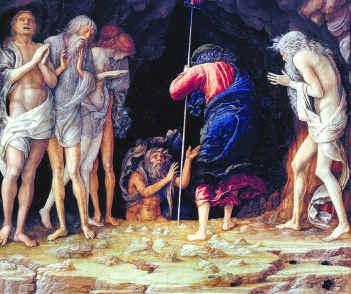
and Sendak's cover for "We are all in the Dumps with Jack and Guy"
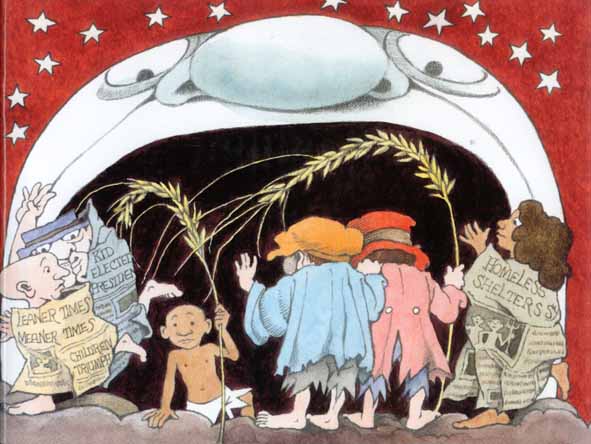
September 19, 2005
The Shakespeare Thing
I was just watching a tape of one of my many Shakespeare documentaries and I was wondering - why haven't I done a Shakespeare panel in stained glass? After all, I have held a near obsession with the plays of Shakespeare for more than 25 years. I've seen every play. I've done other stained glass panels dedicated to literary figures - why not Shakespeare?
I had thought of doing a Shakespeare panel in the Quotation series, using this quote, from "All's Well that Ends Well" -
"The web of our lives is of a mingled yarn, good and ill together: our virtues would be proud, if our faults whip't them not; and our vices would despair, if they were not cherished by our virtues. "
The general ideas come but the images don't. The composition and structure alludes me. For instance, I have a commission for a Shakespeare window but I have yet to crack the design problem. It is to be a Shakepeare insult panel - inspired at least somewhat by the famous internet Shakespeare insult generator, featuring a mix of fake but real sounding generated insults and some insults taken directly from the plays. My favorite Shakepearean insult is most likely to be front and center in the panel -
from King Lear
OSWALD
What dost thou know me for?
KENT
A knave; a rascal; an eater of broken meats; a
base, proud, shallow, beggarly, three-suited,
hundred-pound, filthy, worsted-stocking knave; a
lily-livered, action-taking knave, a whoreson,
glass-gazing, super-serviceable finical rogue;
one-trunk-inheriting slave; one that wouldst be a
bawd, in way of good service, and art nothing but
the composition of a knave, beggar, coward, pandar,
and the son and heir of a mongrel bitch: one whom I
will beat into clamorous whining, if thou deniest
the least syllable of thy addition.
Now, that's an insult. But what pictures to put with it? There is always the approach of simply putting a portrait of Shakepeare with the quote, but that seems a bit strange with the insult quote. Perhaps make it all text, with different dynamic fonts. That might be the best approach. Perhaps one that somehow subtly incorporates the famous Dreoshout portrait (the one on the first folio) of Shakepeare.
July 04, 2005
"Yes, I need Tuesday"
Another interview with Maurice Sendak, this time on the Horn Book website from 2003, before Brundibar was published. I'm constantly surprised that with each new interview I read there is always something new, always something amazing.
February 10, 2005
Googling "New Glass"
Iíve been looking at my library recently after getting my books out of storage. I find I only have 25-30 specifically on stained glass, but they are a choice selection. For instance, I keep saying I should get a Tiffany book, but I think... maybe not, I can always go to the library.
One book of note I do have Ė One I remember getting very well -
New Glass by Otto Rigan.
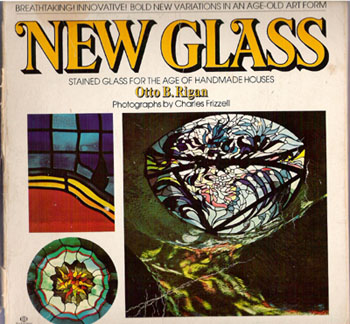
--my own well worn copy--
I first came across it when I was a teenage hobbyist in the 1970's. My primary exposure to stained glass up to this point had been in a few churches and in (I hate to admit) pattern books. I had seen very little stained glass of merit up to that point and almost nothing in a more contemporary style. So, this book was an eye opener.
It's almost 30 years since its publication and I was wondering how many of these artists are still working in stained glass. The first step - Google, of course!
Of the 25 artists mentioned in the book (including the author), fewer than half are still actively working in stained glass, perhaps as few as a third.
For instance, Otto Rigan, the author, is a working artist but he seems to be doing only sculptural public art works. Granted, some of those sculptures incorporate glass, but not in a way that suggests stained glass windows.
Paul Marioni and Dick Weiss I could only find as part of gallery websites. Paul Marioni has some of my favorite pieces in the book. Not surprisingly to me, his career veered more toward studio glass in the 80ís and has never looked back. If he were being judged solely by internet exposure, he is best known now as a teacher or as the father of Dante Marioni.
Dick Weiss is an interesting case in that he is one of the few to be doing more stained glass than he did 15 Ė 20 years ago. That is, he seems to have come back to it after thirty years of doing other conceptual art. This is evidenced by the stained glass screens and the painted work he is making. He is one of the few whose work has evolved and whose recent work is more interesting to me than the work from 30 years ago.
Judy Raffael, another one whose work in the book I especially like, seems to have turned entirely to painting. That is, if I have the right person. If Judy Raffael transformed into Judy North, she is now exclusively a painter. No mention of stained glass.
The artists who are working in stained glass (or thereabouts) and have full fledged websites include Peter Mollica, Elizabeth Devereaux, Kristin Newton (in Japan!), and the inimitable Narcissus Quagliatia.
Dan Fenton does mostly fused glass and is best known for his workshops.
Ed Carpenter and James Hubbell have studios that are devoted to designing entire architectural environments, with stained glass being a small element, if used at all.
Bill Cummings moved to Western Massachusetts, runs a well known studio and has worked with many well known designers. I have visited the studio and know a number of people who have worked there.
I could find nothing on Jad King, Kerry Kelly, Fred Abrams, Sanford Barnett, Judy Jansen, Terry Markarian, Peter Wickman. There was very little on Kathie Stackpole Bunnell, Mark Adams or Hilda Sachs. I remember Bunnell having the biggest buzz in the Boston area in the early 80ís when I first entered stained glass professionally.
There were many references to Robert Kehlman, but more on his role as a writer on glass art than as a glass artist. There is reference to a book of his artwork, but none of his artwork to be found on the internet. He did write a book on 20th century Stained Glass, but Iíve never seen it and it seems hard to locate. Curious.
Some of this may have to do with the vagaries of internet searches, of course. Common names are never as easy to search as unique names, for instance. And, of course, thatís just as far as I can tell from one afternoonís googling.
November 09, 2004
One year of blogging
This blog is one year old this week and it seems time for a brief overview. First of all, my orginal intention was to post at least once a week. Well, I've done a little better than once every 2 weeks. Not too bad, I guess, considering most blogs whither away after a few months.
I had to jettison the comments. Very few comments had been posted and I had little time to respond to those that were. More importantly, the comments section had started to receive spam and it's not worth policing that.
I have started to think of other blogs that might serve needs not covered by this blog. One would be a stained glass community blog. That is, one that would feature a group of authors and would encourage comments and discussion. I hope to see this developed one way or another over the next few months. Time will tell.
Another idea I have for a blog has to do with the large number of drawings that I have in reserve and how I would like to start showing those. I know that I could do that through this blog, but something tells me I need to structure it differently. Anyway, I have a prototype worked out that features one drawing a day. If this works out I will have a permanent link on the main website and on this blog.
October 28, 2004
Busy days...
Many ideas for entries and no time to flesh them out. I've been busy nonstop on a new commission, a floral panel, which is overdue. I have made the time to update my website. I've added some of the pieces completed in the last 2 years and added a page for pieces that are available for purchase.
July 16, 2004
My friend Alice
I should mention that while I was in the Boston area I stayed with Alice Johnson, a good friend and patron and rather amazing stained glass artist.
One of my favorite panels by Alice is this cat dreaming of being a tiger.
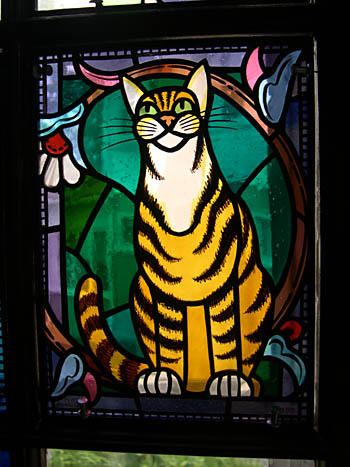
Alice is also the one who commissioned the panel that won me the SGAA Corning International Open Competition Prize (or something like that) back in the late 80's. She was also the prime mover (with Nancy Nicholson) of the fun and fascinating Stained Glass Exquisite Corpse project from about ten years ago.
more later.....
June 04, 2004
Still designing - a glimpse
Though I haven't been creating many stained glass panels of my own recently, I have been designing. I'm always designing. I'm at least always drawing, and that drawing is mostly with stained glass in mind.
Here is a glimpse of what I'm referring to. Photos of the sketchbooks I've been drawing in for the past 2 years or so. They are starting to make quite the pile....
Here's one view of the stack...
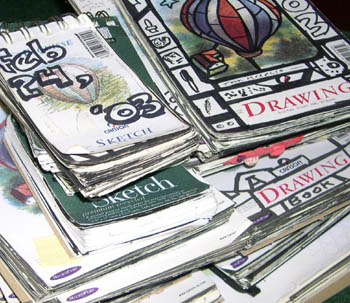
and here's another view, with them laid out...
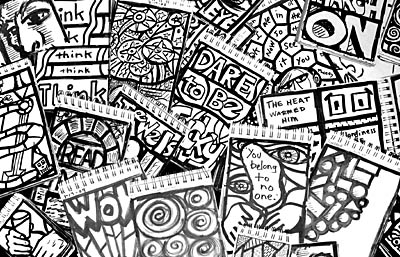
and that's just a glimpse.
Egad. I need to get busy.
April 23, 2004
The English jumble thing
Courtesy of the Stained Glass Network ListServ, this link to a website for Corpus Vitrearum in Britain (listed by location) - Lots and lots of pictures of British Medieval and Renaissance stained glass. From York Minster to Canterbury Cathedral and many many small parish churches, there seems to be literally thousands of images to see. Quite amazing.
This does make a good place to mention my fascination with what I refer to as the "English Jumble Window".
This is a uniquely British phenomenon of stained glass where a window has been willfully destroyed (most likely by the Puritans), but some of the pieces survive and it's reassembled. That is, at a later date, someone reglazes the glass pieces into a new stained glass panel. This is done in a manner that more or less preserves the general composition but throws in old bits of other windows, clear glass or whatever-can-be-found to fill the gaps. The degree of 'jumbling' varies widely. The result is a window that, on first glance, looks like an old stained glass window with a bit of repair done. On closer examination it can seem like Cubism had its true origin in British stained glass.
A specific example - one that I actually saw myself on a trip to the Lakes District, when I visited a small parish church named Cartmel Fell in 1991. The guidebook called the East Chancel Window something like 'one of the finest and most complete examples of 15th century English stained glass". I was struck by the fact that perhaps only 20-30 percent of the original window was actually there in front of me, vaguely discernable in its composition. And I liked it. The appeal for me came partly in the detective/puzzle work of figuring out what the original scene looked like and partly a vague curiousity/fascination with the jumble itself.
East Chancel Window, Cartmel Fell
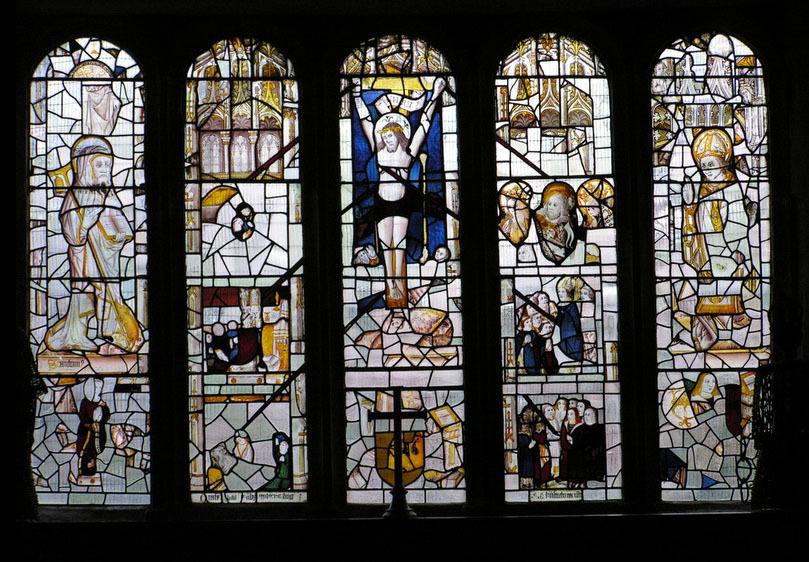
photo via davelynne - click for larger image
I have a sneaking suspicion that I might even like the jumble window better than the original window, though that's hard to prove. I just find the jumble panels to be intrinsically appealing.
My own patchwork panels are very much influenced by these English jumble panels. The patchwork panels have no pre-set design. Each panel is designed with the glass itself, using old test pieces, extras from old panels, and stock pieces of painted and etched glass. The process is one of improvisation. Sometimes it works, sometimes not. But it's never predictable.
And I like that.
[update May 18, 2009 - new better photo of the Cartmel Fell window and additonal info if you check out the page of Flickrite davelynne]
March 25, 2004
The Sendak Thing...
In the past 4-5 months there have been a slew of interviews and articles about Maurice Sendak, coinciding with the publication of his latest (and possibly last) picture book, Brundibar, as well as a new book of his artwork, The Art of Maurice Sendak 1980-the present, written by Tony Kushner.
I'm glad to say some of the interviews are available for listening on the internet. The FreshAir Interview, the Diane Rehm Interview and most recently a video interview on NOW with Bill Moyers. The Moyers interview (especially interesting) can also be read as a transcript.
All have brought up strong memories and strong emotions for me. I would not be an artist had it not been for Maurice Sendak. Not just the picture books that I saw as a kid (and into my adult years), but also the interviews with him. His intellect, his perspective on art and life have had a deep influence on me.
I remember seeing him in a short documentary film about children's literature when I was young and being fascinated by the process of drawing and making picture books. Fascinated by seeing him draw. I remember him demonstrating a flip book, where drawings became that amazing thing - 'animation'.
So the question arises, what appeals to me about his work? Foremost, there is breadth and depth to it. There are a variety of styles contained in his illustrations. This, to me, reflects the very richness and complexity of the human experience. I've always been less interested in the artist who has 'one style' throughout a career. I just don't understand it.
He has a willingness, almost compulsion, to stretch his artform to its limit, and yet to stay within this medium of 'illustration'. Be it for theater or literature, the work is illustrating another 'text'. It's difficult to describe why this appeals to me so much. The idea of balance between tradition and experiment appeals to me. I like the growth and the limitation. I feel it in the same way that I wish to stay within the "limitation" of working in the medium of the traditionally crafted stained glass window and yet I wish to apply the widest range of graphic possibilities to that medium.
And then there are the interviews. The first key interview I read was one he did with Jonathan Cott initially for Rolling Stone Magazine in December of 1976, then anthologized in Cott's book "Pipers at the Gates of Dawn". I was 17 when I read it and this interview first set my mind to thinking about art - about making art myself. I haven't stopped thinking about it since.
Initially, the most appealing aspect of these interviews was reading of the self taught nature of his learning. His 'school' education was limited and mostly disdained. Yet he displayed a voracious appetite for learning, especially for learning his art - unimpeded by Academia!
This viewpoint opened up a whole new world for me. I could learn and figure things out by myself. Learning could be an active pursuit and not a passive 'taking in'. It was very liberating for the rather uptight and timid teenager that I was.
And yet I've been timid about this all these years. Just too difficult to explain, I suppose. Something along the lines of - "Why on earth would a stained glass artist be most influenced by a children's book illustrator?" I don't think I felt any shame at being influenced by such a "lowly" art form as children's book illustration. Yet I know I avoided talking about it for fear it would make a conversation too difficult. This happened most often when I discussed my art with people who seem to represent a 'higher' form of art, especially gallery people and museum people.
So, I have come to the realization, especially after this latest round of Sendak interviews, that I need to be honest and forthright about myself, my influences and, ulitmately, my own viewpoint of the world. That is what being an artist is about anyway. This man, who I believe is one of the greatest visual artists of the past century, deserves that. If I am going to publicly state his influence on my work and world view then I owe it to him to dive deep and be honest.
February 20, 2004
The Sketches and The Ambivalence
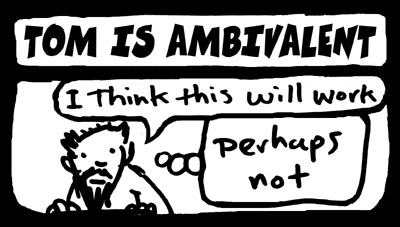
about blogging, that is.
I sketch all the time. I do not write all the time. Drawing comes easy to me - it is and has always been a pleasure to me. Writing, in contrast, can be akin to torture for me. Yet, writing has become a necessity. There are things I must write about. If only for myself - for clarity within myself. One ambivalence I feel in writing a blog is the public nature of it. Even though the 'audience' will certainly be very limited, there is nevertheless a sense that this is public writing. This is not intended as a diary form blog. Hence the delay in doing regular submissions. I'm still trying to get the hang of this brave new world.
The advantage of public writing is that it does force me to keep on my toes. I do have a reader in mind. My solitary writing tends to spin out into stream of consciousness. It can be a fun and wild ride, but it is not conducive to thinking through an idea to a structured end. The nature of 'public' writing seems to help me, compel me, to think more carefully.
My sketches are also stream of consciousness. I rarely sketch from life. I tell people often that for every stained glass panel I finish I have at least 50 sketched out. I've never really counted, but I'm beginning to think that might be an underestimate. I recently took a stack of thumbnail sketches I did about 2 years ago and scanned them into the computer. I have yet to make a panel based on any of these sketches, and I know there are at least 1,200 sketches in the stack. Granted, they were small thumbnail sketches, many being no more than the size of a large postage stamp. Yet they are all sketches for stained glass windows and could be made into panels.
And what keeps me from making them into panels? Time factors in, of course. The myriad distractions of work for money, family, children, commitments. But I suspect there is also that pesky ambivalence that says, "You may have 1,200 sketches, but I only see maybe 6 good designs in there, if that."
That's when my public self chimes in -
6 designs is good. Do it.
okok I will. I promise.
Someday. Soon really.
November 06, 2003
The beginning
My name is Tom Krepcio and I am a stained glass artist. This weblog is (mostly) about stained glass windows. That is to say, my perspective on this curious art/craft form. The present, the past and the future. The good, the bad, the beautiful and the just plain weird. okokok, especially the weird. More accurately, I plan to focus on topics that do not seem related to stained glass at all. And that is the point, since I feel that stained glass has limited itself in so many ways and so, well, it needs a bit of a stretch.
that is to say - Dare to be weird.
I have been working in stained glass for more than 30 years, having started as a pre-teen hobbyist in the early 70's. I have been working in the field professionally since 1980. The simplest way of grasping my personal history with stained glass is to look at my resume and the first part of my "Vitreobiography" and, of course, to look through my work on my web site. I am currently the Studio Manager at Salem Stained Glass in East Bend, North Carolina, and I still keep up with my personal work and my own commissions.
This is a self portrait (officially - "Portrait of the Artist in 1989 with Plaids and a Pencil") I did a long time ago. Some say it does not look like me, but then the drawing was from 1989... and it's more a "self caricature" than a self portrait.
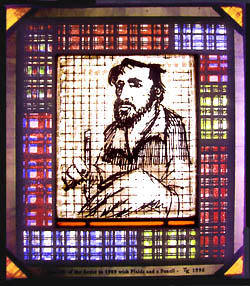
My goal for this blog is to make at least one entry per week - more if the routine kicks in. Enjoy the ride.
